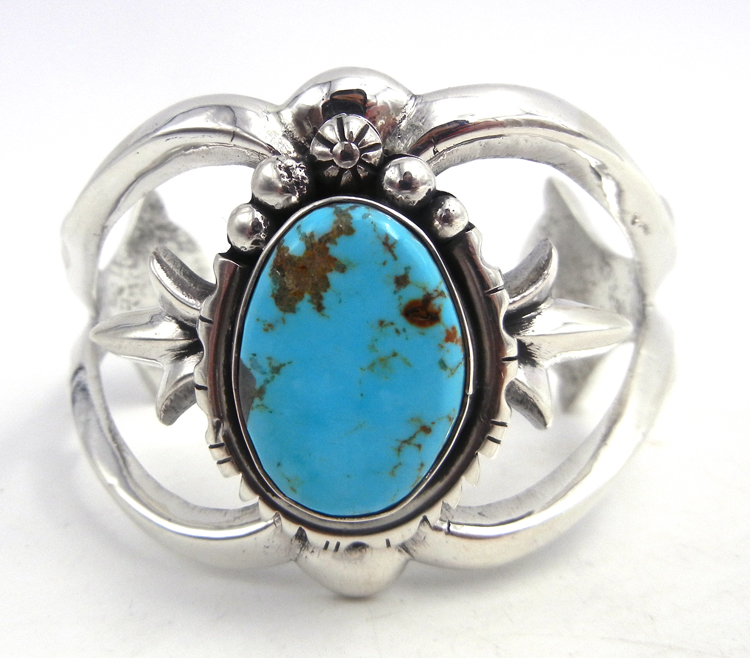If your Native American turquoise jewelry has changed color over the years, you might be worried the color change means you don’t own real turquoise jewelry. However, there is still a good chance your turquoise is authentic despite these color changes.
Let’s explore this alluring stone’s place in history, its characteristics, and care to understand what’s impacting the color of your turquoise.
Understanding Turquoise
Turquoise occurs naturally in several areas of the world, which contributes to the diverse color palette of this intriguing stone. This secondary mineral is found in arid regions, often near copper deposits, as it requires interactions with other minerals to create its distinct color and matrixes (veining).
A coveted stone featured in Native American jewelry, turquoise has also been a status symbol and distinctive detail in ancient artifacts around the world for millennia. Dating back to 3,000 BCE, turquoise was mined by the Ancient Egyptians, who used it not only for jewelry but also to decorate ceremonial objects. It was also used in Ancient China and Persia (now known as Iran), and the Persians introduced turquoise to Medieval Europeans.
Turquoise also features prominently in cultural beliefs, whether it is used in shields and weapons for its protective powers, as a talisman to predict illness, as a symbol of peace and tranquility, or as the secret to immortality.
Native Americans most often set their turquoise in silver. However, jewelers in Iran, the Middle East, and even Victorian England used gold. Today, gold settings are making a comeback, but silver settings remain dominant throughout the Southwest. Decorative items such as polished turquoise bookends, paperweights, or mosaic art also appear in homes around the world.
Factors Behind Color Change
Metals such as aluminum, copper, or iron that are prone to rusting naturally occur in turquoise. As a result, prolonged exposure to water and oils can cause turquoise oxidation, creating greener tones in bluish stones and deeper tones in green stones.
Because turquoise is a very porous material, it is vulnerable to environmental factors such as light, heat, and chemicals. Exposure to household cleaners, beauty products, and natural skin oils can contribute to color changes.
While the highest quality of “precious” turquoise is more resistant to color change, lesser quality stones are often treated with a process called stabilization to help prevent oxidation. Although this helps stabilize the natural colors, special care is needed to protect the treatment. This includes avoiding cleaning solvents, chemicals, oils, and heat, which can all contribute to permanent changes in your turquoise’s color.
Identifying Authentic Turquoise
Color changes can also be a result of imitation turquoise. For example, when turquoise turns white, it is most likely howlite, a white calcium carbonate mineral dyed to look like turquoise. Counterfeit turquoise contributes to color instability, impacts value, and can even release toxins.
Therefore, when shopping online or in the Albuquerque area, it’s important to be aware of the differences between real turquoise stone and imitation turquoise, such as howlite, magnesite, or, in the worst-case, plastics/resins.
How To Tell if Turquoise Jewelry Is Real
When identifying real turquoise commonly found in the Southwest, such as Sleeping Beauty and Kingman, look for the following qualities:
- The stone is hard and heavy
- Tones are muted as opposed to artificial, unnatural-looking colors that seem too pure, bright, blue, or green
- Sleeping Beauty turquoise should have a consistent bluer color without matrix
- Kingman turquoise should be sky blue to blue-green with black or brown matrix
- Hints or dominant matrix occur naturally in turquoise
- A smooth, waxy surface that doesn’t feel gritty
- Completely opaque when held up to light
- No obvious blotches, uneven color, or signs of intentional matrix
Preserving the Integrity of Turquoise
You can preserve the integrity of turquoise Native American jewelry using these important tips.
- Remove your turquoise jewelry when doing any of the following:
- Cleaning
- Showering
- Swimming
- Sunbathing
- Applying lotions, soaps, creams, cosmetics, or perfumes
- Do not wear latex or wool gloves when wearing your real turquoise rings.
- Store your jewelry in individually sealed plastic zip-top bags in a jewelry box or a cool, dark, and dry area.
- Limit moisture by using activated charcoals or silica in your jewelry storage area.
- Avoid using silver polishes; use a non-abrasive cloth to remove tarnishing.
- Never soak turquoise jewelry in cleaning solutions, as this will damage both the silver settings and the stone.
Seeking Professional Assistance
When caring for your turquoise jewelry, it’s important to seek the advice of a reputable gemologist or expert. Such professionals can also advise you if you aren’t sure how to deal with discolored or damaged turquoise to ensure you don’t cause further damage by trying to restore the color.
Professional restoration services will revive the color, ensuring you maintain the value of your turquoise possessions. Although the subtle nuances of oxidation tell a story about your turquoise’s history, preserving the original color maintains the stone’s natural character.
Stop By Palms Trading Company for Authentic Turquoise Jewelry!
If you’re wondering where to buy real turquoise jewelry, check out Palm’s Trading! We are a trusted, authentic Native American company with a convenient store in Albuquerque. We also offer our customers online sales delivered across the U.S.
Contact us today to find your next piece of authentic turquoise jewelry.



